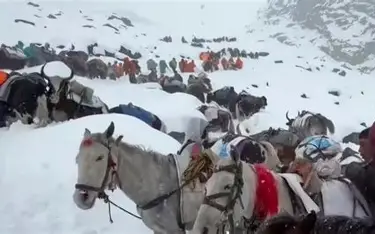Beijing, October 6, 2025 — A sudden snowstorm on Mount Everest has trapped hundreds of hikers and climbers during China’s National Day holiday, prompting a large-scale rescue operation by Nepalese and Chinese authorities. Officials confirmed on Monday that at least 312 people were stranded in treacherous conditions near the north and south base camps as heavy snowfall and powerful winds swept across the Himalayas.
Rescue teams from both Nepal and China have been dispatched to the region, where communication has been severely disrupted. The storm, which began late Saturday, intensified overnight and continued through Sunday, burying trails under several feet of snow and cutting off key supply routes.
According to China’s Ministry of Emergency Management, at least 90 Chinese citizens were among those stranded. The ministry said coordination with Nepalese authorities is ongoing, with helicopters and specialized mountain rescue units preparing to reach isolated climbers once weather conditions improve.
Local officials described the situation as “extremely dangerous,” with temperatures plunging below minus 25 degrees Celsius and visibility near zero. “Rescue operations are very difficult due to the high altitude and constant snow,” said Lobsang Sherpa, a coordinator for Nepal’s tourism department. “Our priority is to locate and evacuate those who are in critical condition.”
The storm struck as thousands of tourists traveled to the Himalayas to celebrate China’s weeklong National Day holiday, traditionally a peak season for mountain expeditions and trekking tours. Many climbers were already en route to advanced camps when the weather changed abruptly.
A number of rescue shelters have been established in lower-altitude areas, and authorities are urging those who can descend safely to do so. “We have received distress calls from multiple groups,” said Chen Rui, an official with the China Mountaineering Association. “Some have taken refuge in temporary tents or caves, but others remain missing.”
Nepalese army helicopters attempted several rescue flights on Sunday afternoon but were forced to turn back due to high winds and whiteout conditions. Officials said air support may resume once the weather stabilizes, possibly by Tuesday morning. Ground teams, including trained Sherpa guides and local volunteers, are working on foot to reach stranded climbers.
Eyewitnesses described chaotic scenes as the snowstorm swept through the region. “It came out of nowhere,” said Zhang Mei, a climber from Sichuan Province who managed to reach safety at the base camp. “The sky went dark in minutes, and the wind was so strong that tents were flying away. Many people were separated from their groups.”
Meteorologists said the storm was triggered by a sudden shift in upper-level jet streams, which caused a collision of warm and cold air over the Himalayas. The China Meteorological Administration had issued a warning for heavy snowfall in the Everest region last week, but the severity of the storm appears to have exceeded forecasts.
Local hospitals in Tibet and Nepal’s Solukhumbu District have been placed on alert, preparing to treat cases of frostbite, altitude sickness, and hypothermia. “We are expecting injured climbers to arrive as soon as the weather clears,” said Dr. Nima Dawa of the Lukla Regional Medical Center.
Authorities in both countries have urged families of missing climbers to remain calm as search operations continue. “We are doing everything possible to bring everyone home safely,” said Nepal’s Home Ministry spokesperson, Prakash Thapa. “This is one of the worst weather events in recent years during the climbing season.”
As night fell on Monday, many stranded hikers were still unaccounted for. Emergency crews are monitoring satellite signals from GPS trackers carried by expedition teams to pinpoint locations. The United Nations Disaster Relief Coordination Office said it is ready to assist if international aid is requested.
Tourism experts warn that the incident could have lasting effects on Himalayan travel, as questions arise about safety protocols and the growing number of climbers attempting high-altitude treks during peak holiday periods. “This tragedy highlights the dangers of overcrowding and unpredictable mountain weather,” said Liu Zhen, a Beijing-based travel analyst. “More regulation and early warning systems are needed.”
The snowstorm, now weakening, is expected to subside by late Tuesday, allowing full-scale rescue operations to resume. Officials remain cautious but hopeful that most stranded climbers will be recovered alive.
For now, families across China and Nepal are anxiously awaiting news from their loved ones trapped on the world’s highest peak as the rescue effort continues through freezing winds and deep snow.



